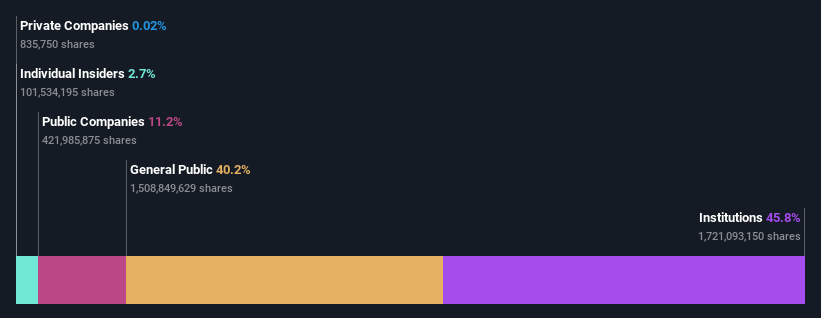Inari Amertron Berhad's (KLSE:INARI) large institutional owners must be happy as stock continues to impress, up 5.2% over the past week
Key Insights
Significantly high institutional ownership implies Inari Amertron Berhad's stock price is sensitive to their trading actions
A total of 14 investors have a majority stake in the company with 51% ownership
Analyst forecasts along with ownership data serve to give a strong idea about prospects for a business
If you want to know who really controls Inari Amertron Berhad (KLSE:INARI), then you'll have to look at the makeup of its share registry. The group holding the most number of shares in the company, around 46% to be precise, is institutions. Put another way, the group faces the maximum upside potential (or downside risk).
Last week’s 5.2% gain means that institutional investors were on the positive end of the spectrum even as the company has shown strong longer-term trends. One-year return to shareholders is currently 55% and last week’s gain was the icing on the cake.
Let's take a closer look to see what the different types of shareholders can tell us about Inari Amertron Berhad.
Check out our latest analysis for Inari Amertron Berhad
What Does The Institutional Ownership Tell Us About Inari Amertron Berhad?
Institutions typically measure themselves against a benchmark when reporting to their own investors, so they often become more enthusiastic about a stock once it's included in a major index. We would expect most companies to have some institutions on the register, especially if they are growing.
Inari Amertron Berhad already has institutions on the share registry. Indeed, they own a respectable stake in the company. This can indicate that the company has a certain degree of credibility in the investment community. However, it is best to be wary of relying on the supposed validation that comes with institutional investors. They too, get it wrong sometimes. It is not uncommon to see a big share price drop if two large institutional investors try to sell out of a stock at the same time. So it is worth checking the past earnings trajectory of Inari Amertron Berhad, (below). Of course, keep in mind that there are other factors to consider, too.
We note that hedge funds don't have a meaningful investment in Inari Amertron Berhad. Our data shows that Insas Berhad is the largest shareholder with 11% of shares outstanding. In comparison, the second and third largest shareholders hold about 10% and 9.5% of the stock. In addition, we found that Kean Lau, the CEO has 1.3% of the shares allocated to their name.
A closer look at our ownership figures suggests that the top 14 shareholders have a combined ownership of 51% implying that no single shareholder has a majority.
Researching institutional ownership is a good way to gauge and filter a stock's expected performance. The same can be achieved by studying analyst sentiments. Quite a few analysts cover the stock, so you could look into forecast growth quite easily.
Insider Ownership Of Inari Amertron Berhad
The definition of company insiders can be subjective and does vary between jurisdictions. Our data reflects individual insiders, capturing board members at the very least. Company management run the business, but the CEO will answer to the board, even if he or she is a member of it.
Most consider insider ownership a positive because it can indicate the board is well aligned with other shareholders. However, on some occasions too much power is concentrated within this group.
Our most recent data indicates that insiders own some shares in Inari Amertron Berhad. It is a pretty big company, so it is generally a positive to see some potentially meaningful alignment. In this case, they own around RM330m worth of shares (at current prices). Most would say this shows alignment of interests between shareholders and the board. Still, it might be worth checking if those insiders have been selling.
General Public Ownership
With a 40% ownership, the general public, mostly comprising of individual investors, have some degree of sway over Inari Amertron Berhad. While this group can't necessarily call the shots, it can certainly have a real influence on how the company is run.
Public Company Ownership
Public companies currently own 11% of Inari Amertron Berhad stock. This may be a strategic interest and the two companies may have related business interests. It could be that they have de-merged. This holding is probably worth investigating further.
Next Steps:
It's always worth thinking about the different groups who own shares in a company. But to understand Inari Amertron Berhad better, we need to consider many other factors. Case in point: We've spotted 2 warning signs for Inari Amertron Berhad you should be aware of.
Ultimately the future is most important. You can access this free report on analyst forecasts for the company.
NB: Figures in this article are calculated using data from the last twelve months, which refer to the 12-month period ending on the last date of the month the financial statement is dated. This may not be consistent with full year annual report figures.
Have feedback on this article? Concerned about the content? Get in touch with us directly. Alternatively, email editorial-team (at) simplywallst.com.
This article by Simply Wall St is general in nature. We provide commentary based on historical data and analyst forecasts only using an unbiased methodology and our articles are not intended to be financial advice. It does not constitute a recommendation to buy or sell any stock, and does not take account of your objectives, or your financial situation. We aim to bring you long-term focused analysis driven by fundamental data. Note that our analysis may not factor in the latest price-sensitive company announcements or qualitative material. Simply Wall St has no position in any stocks mentioned.

 Yahoo Finance
Yahoo Finance 

